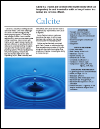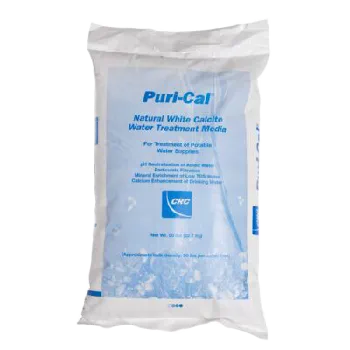Popular and Cost-Effective Media to Raise pH
Calcite is a natural mineral media consisting of about 95% calcium carbonate and roughly 3% magnesium carbonate. It is most often used to reduce corrosion risks by boosting the pH of acidic water, and lighlty re-mineralizing water after reverse osmosis treatment. It is also used to boost pH to improve the performance of subsequent water treatment processes (most often for iron or manganese treatment). Calcite is sacrificial - it slowly dissolves into calcium, magnesium, and bicarbonate ions which neutralize free hydrogen ions to reduce acidity. As it is used up, it needs to be replenished over time. Calcite acts slowly thereby offering controlled pH neutralization without the risk of over-correction.
The slow acting nature of calcite makes it less ideal for larger pH adjustments (where feed pH < 6.0). Accordingly, it is often combined with Corosex (magnesium oxide) for larger pH corrections. Since Corosex can over-correct, it is recommended to start with a relatively low ratio of Corosex (about 10% Corosex, 90% Calcite) and blend at a consistenly higher ratio until the target pH level is achieved, up to a maximum recommended ratio of 50/50. For applications where your pH level is less than 5.0, please contact us for advice.
Calcite Advantages:
- Natural mineral rock
- low cost
- Relatively wide range of effectiveness - pH from 6.0 to 6.9
- Will not overcorrect/overboost
- Certified to NSF/ANSI Standard 60
Calcite Disadvantages:
- Slow acting, neutralization may be incomplete when pH is below 6.0
- Increases water hardness (calcium, magnesium)
The fact that calcite is self-limiting is perhaps its greatest operational advantage - it boosts pH enough to reach a non-corrosive equilibrium. As the calcite dissolves, calcium and magnesium ions will be added to the water. Since these ions contribute to water hardness, a calcite filter will increase the water hardness. A water softener may be required particularly if the feed water hardness was already in excess of 5 grains / gallon. In most situations, hardness will increase 30-100 mg/l (2-5 grains per gallon). if an increase in hardness may be problematic to your product water, we recommend that pilot testing be done to determine the expected hardness increase under your specific water chemistry and operating conditions
A gravel underbed is strongly recommended.
Operating Conditions / Requirements:
| Service Flow Rate: | 3 to 6 GPM/ft2 |
|---|---|
| Flow Direction: | Upflow or Downflow |
| Backwash Flow Rate (Downflow Service): | 8-12 GPM/ft2 |
| Backwash Bed Expansion: | 35% |
| Typical Freeboard: | 50% |
| Minimum Bed Depth: | 24 Inches |
| Recommended Bed Depth: | 30-36 Inches |
| Recommended pH: | 5.0 to 7.0 |
| Weight: | 90 lbs per ft3 |
| Service Flow Rate: | 3 to 6 GPM/ft2 |
|---|---|
| Flow Direction: | Upflow or Downflow |
| Backwash Flow Rate (Downflow Service): | 8-12 GPM/ft2 |
| Backwash Bed Expansion: | 35% |
| Typical Freeboard: | 50% |
| Minimum Bed Depth: | 24 Inches |
| Recommended Bed Depth: | 30-36 Inches |
| Recommended pH: | 5.0 to 7.0 |
| Weight: | 90 lbs per ft3 |
Downloads

